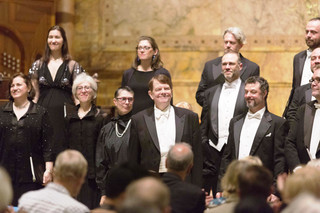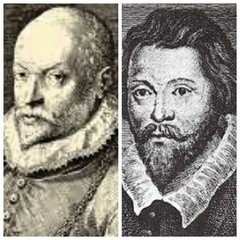|
Back
Rejoicing and Allelujahs New York
Church of the Ascension
05/01/2019 -
Roland de Lassus: Factus est Dominus – Justorum animae – Surgens Jesus – Penitential Psalm No. 6: De Profundis – Christus Resurgens ex Mortuis – Ave Verum Corpus – Surrexit Pastor Bonus – Susanne un jour
William Byrd: Miserere Mei, Deus – Non vos relinquam – Ave Verum Corpus – Rejoice, Rejoice! – Justorum animae – Praise Our Lord – Pavana Bray – My Lord Willoughby’s Welcome Home
Voice of Ascension, Dennis Keene (Artistic Director and Conductor)
Charles Weaver (Lutenist)

D.Keene (center) with some of his “Voices”
(© Roman Dean/Courtesy Voices of Ascension)
“The exercise of singing is delightfull to Nature & good to preserve the health of Man... The better the voyce is, the meeter it is to honour and serve therewith; and the voyce of man is chiefly to be used to that ende.”
William Byrd (1538-1623)
“Light quirks of music, broken and unev’n/Make the soul dance upon a jig to Heaven.”
Alexander Pope (1688-1744)
In my adolescence, I felt that the pristine sounds of Giovanni da Palestrina were the non plus ultra of spiritual music. Religion be damned: This was music of the Inner Spirit, and the rest of the late Renaissance was dross compared to those these chaste puritanical strains.
Later, that most aristocratic Papal composer was (save for the Saved and the Scholar) seemed kinda boring. Through-composed stuff needed more bang for the buck, more emotion. Less God, and more deviltry.
Thus the discovery, first, of Machaut and the Notre-Dame School, because I could picture crypts, dances for the dead, dark horrors and Black Plagues.
And then Roland (his correct name) de Lassus. Not only wondrous counterpoint, not only the best poet-composer until Stephen Sondheim, but music which leaped forward, which painted pictures, that moved and were moving. And last night, the Voices of Ascension gave a splendid selection from the 2,000-odd works which this Flemish composer produced during Elizabethan times. As well as his contemporary William Byrd.
Mind you, the Voices of Ascension was not the Urtext de Lassus. The choir of almost 30 was twice the size of the original 16th Century originals. The women of the Choir replaced the original boys voices. And no instruments, like organ or cello-style continuo were in the background. (That was for de Lassus; Byrd was probably a capella.)
Yet nobody in the Church of the Accession minded the changes, certainly not their Artistic Director-Conductor Dennis Keene. He made certain that not any of the motets, not even the two Masses, were given a lachrymose treatment. As in their originals, the choir swung briskly along, with almost jaunty pacing. The Allelujah from de Lassus’ Risen is the Good Sheperd swung echoed around the church like the later Handel famed chorus. When an “Amen” was extended as at the end of the de Lassus Mass, one felt that it was a rejoicing “Amen.” Or one could hear a startling de Lassus “Amen” in Ave Verum Corpus in a totally different key.
(One discordant note: Where was the Credo in the de Lassus Mass? Under Mr. Keene’s hands, this Credo would rock!)
It seemed natural that Mr. Keene conducted his long-time Voices of Ascension choir with such joy. He is one of the only program annotators who not only offers sufficient knowledge but actual personal enthusiasm. (A word which means “The Spirit within.”)
Mr. Keene chooses adjectives like “transcendent ” and “brilliant” and seduces us by saying “We cannot help but be drawn into (it)”. ” He modestly says he can’t choose between the two Ave Verum Corpus motets, because one is “sublime”, the other “more human.”
And this was how he conducted. Except in a few extreme contrapuntal texts, the Latin was translucent, the voices well balanced.

R. de Lassus/W. Byrd
Even more essential, Mr. Keene easily demonstrated the sharp differences between the two composers. When Roland de Lassus speaks of the disciples “rejoicing” at the Eminence of Christ, the Voices of Ascension rejoiced with the words. In fact, at times the jumble of voices here sounded like something from a Penderecki choral piece.
William Byrd had his moments. In the Sanctus section of his Mass, one heard a sudden chorale when speaking of “Glory”. In the English-language Praise Our Lord, one could virtually see the student choir of a 17th Century public school.
Perhaps one might have wanted a greater selection of Tudor and European composers of the era, for the differences were all great. Mr. Keene did present two interludes, next to his vibrant singers. The lutenist Charles Weaver was delicate, elegant, very sensitive with his lute playing.
Yet this music was written for the home, or perhaps to be sung at one of Master Shakes-peere’s dramas. Mr. Keene gave us glorious church music. That renegade Catholic William Byrd wrote for the Established Church with the same presence that Lutheran Bach wrote for the Catholic Church. And Roland De Lassus, perambulated around Europe, with all his music reflecting what must have been an extraordinary mind.
Harry Rolnick
|